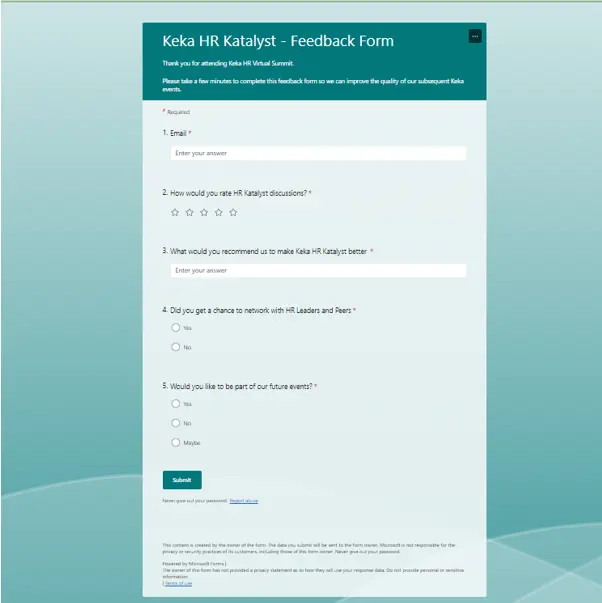The worst nightmare of an entrepreneur can be an unhappy customer with the product or service. A question that keeps haunting the minds of entrepreneurs is “Are my customers truly satisfied?” And the dilemma continues, businesses thought they struck gold but often their customers slipped out through the cracks. It feels disgusting to be not able to feed what your customers are looking for. Here CSAT surveys questionnaire, as a result, it provides you precise insights into your customers’ feelings and satisfaction levels.
Also, your customer is not looking for an ordinary survey to be filled. The goal of the survey is to improve customer experience, gather feedback, and create a survey questionnaire with the idea to obtain uber-relevant information in the form of data.
In this blog, we’ll help you to about the nitigrities of customer surveys, types of customer survey questions, examples, and best practices to craft customer satisfaction surveys.
Let’s get it done.
But first, what are customer satisfaction surveys?
What are Customer Satisfaction Surveys?
Customer Satisfaction Surveys are tools used by businesses to measure how happy and satisfied their customers are with their products, services, or overall experience. These surveys typically consist of a series of questions that customers can answer, expressing their opinions, feedback, and levels of satisfaction.
Customer Surveys gather this information, companies can understand what aspects of their offerings are meeting customer expectations and where improvements may be needed. Customer Satisfaction Surveys provide valuable insights that help businesses make informed decisions to enhance customer experiences and ensure their needs are met effectively.
Why use customer satisfaction surveys?
Using CSAT surveys questionnaire is like having a secret superpower as a business owner. It’s like having a crystal ball that allows you to peek into the minds of your customers and understand what they really think about your products or services. Just imagine being able to read their minds without any psychic abilities!
These surveys are like your own personal detectives, gathering valuable clues and evidence to solve the mystery of customer satisfaction. They help you uncover what makes your customers happy and what might be causing them frustration or dissatisfaction. It’s like having a direct line to your customers’ thoughts and feelings, giving you insights that can guide your business decisions.
Think of it this way: remember those choose-your-own-adventure books? Customer satisfaction surveys are like those, but for your business. They allow your customers to choose their own adventure by providing feedback on their experiences. And just like in those books, their choices (or in this case, their answers) help shape the story of your business. With each survey response, you gain a clearer picture of what your customers want and how you can make their experience even better.
So, using customer satisfaction surveys is like having a powerful tool that helps you understand your customers’ needs, fix any issues, and create a better business adventure for everyone involved. It’s like having a magical insight potion that keeps your customers happy and your business thriving.
Types of Customer Satisfaction Survey Questions
Rating Questions:
1. How would you rate the support you received?
This question aims to gauge the customer’s satisfaction with the support they received. It typically includes a rating scale (e.g., from 1 to 5 or from very dissatisfied to very satisfied) that allows customers to indicate their level of satisfaction. The ratings provide quantitative data that can be analysed to measure the overall satisfaction level of customers with the support provided.
2. How satisfied are you with the information you received before purchase?
This question assesses the customer’s satisfaction with the information they received prior to making a purchase. It helps determine whether the information provided was clear, comprehensive, and met their expectations. Similar to the previous question, a rating scale is often used to gather quantitative data that enables businesses to evaluate customer satisfaction levels.
Follow-up Questions:
1. How could we improve our product?
This open-ended question encourages customers to provide specific feedback on areas where the product can be enhanced. By soliciting suggestions and constructive criticism, businesses can gather valuable insights to identify areas for improvement. This qualitative data can guide future product development and updates, ensuring that customer needs and preferences are addressed effectively.
2. Would you buy another product from us?
This question aims to measure customer loyalty and the likelihood of repeat purchases. By directly asking customers about their willingness to buy from the business again, companies can assess the strength of their customer relationships. The responses help gauge overall customer satisfaction and identify areas that may need attention to increase customer retention and repeat business.
3. What problems do you try to solve with our product?
This question delves into the specific pain points or challenges that customers are attempting to address by using the product. By understanding the customers’ goals and desired outcomes, businesses can tailor their product offerings and messaging to better meet these needs. The responses provide insights into the real-world problems customers face, enabling companies to align their products with customer expectations more effectively.
Multiple Choice Questions:
These questions provide predefined answer options for customers to choose from. For example:
– Which of the following features do you find most useful?
– How likely are you to recommend our product to others?
Rating Scale Questions
These questions use a scale to measure the level of satisfaction or agreement. Customers select a rating based on their experience. For example:
– On a scale of 1 to 10, how satisfied are you with our customer service?
– Please rate the ease of use of our website on a scale of 1 to 5.
Open-Ended Questions
These questions allow customers to provide detailed responses in their own words. They offer flexibility for customers to express their opinions and provide valuable insights. For example:
– What improvements would you suggest for our product?
– Please describe your overall experience with our company.
Likert Scale Questions
These questions measure agreement or disagreement on a specific statement using a scale. Customers select a response option that reflects their viewpoint. For example:
– Strongly agree, Agree, Neutral, Disagree, Strongly disagree:
“The product met my expectations.”
Net Promoter Score (NPS) Questions
NPS is a popular metric used to measure customer loyalty. Customers are asked to rate their likelihood of recommending the product or company on a scale from 0 to 10. For example:
– On a scale of 0 to 10, how likely are you to recommend our company to a friend or colleague?
Demographic Questions
These questions gather information about customers’ demographics, such as age, gender, location, or occupation. This data helps in analyzing satisfaction trends across different customer segments.
These different question types provide businesses with a range of data to evaluate customer satisfaction levels, identify areas for improvement, and make data-driven decisions. It is important to choose the appropriate question types based on the specific objectives of the survey and the insights needed.
Best practices for designing customer satisfaction surveys
Designing effective customer satisfaction surveys using a CSAT Survey tool is a best practice to ensure high response rates and valuable insights. Let’s delve into some key practices and illustrate them with practical examples:
1. Keep the questions short and simple:
Long and complicated survey questions can confuse respondents and lead to dropouts. It’s crucial to use concise and straightforward language to ensure clarity and encourage participation. For example: – Instead of: “Could you please elaborate on the specific challenges you faced while using our product in the past month?” – Use: “What challenges did you encounter while using our product recently?”
2. Segment your users before sending surveys:
Customer segments may have different needs and expectations. By segmenting your users based on relevant criteria (e.g., purchase history, demographics), you can tailor survey questions to their specific experiences. For instance: – Sending a targeted survey to long-term customers to gauge loyalty and satisfaction with loyalty program benefits. – Sending a survey to new customers to understand their initial impressions and onboarding experience.
3. Trigger customer feedback surveys contextually:
Timing is crucial when seeking customer feedback. Triggering surveys at key touchpoints in the customer journey, such as after a support interaction or post-purchase, allows for feedback that is fresh and relevant. For example: – Sending a survey immediately after a customer support chat session to capture their satisfaction with the resolution and agent’s assistance. – Sending a survey a few days after a product delivery to gather feedback on the shipping experience and product quality.
4. Show gratitude to customers who give detailed feedback:
Customers who take the time to provide detailed feedback deserve acknowledgment and appreciation. Expressing gratitude can enhance their satisfaction and encourage future participation. For instance: – Sending a personalized thank-you email to customers who provide in-depth feedback, expressing appreciation for their valuable insights and how it will help improve their experience. – Offering a small token of appreciation, such as a discount code or exclusive content, as a gesture of gratitude for customers who go above and beyond with detailed feedback.
Certainly! Here are a few additional best practices for designing customer satisfaction surveys:
5. Use a mix of question types:
Incorporate a variety of question formats in your survey to capture different types of feedback. This can include rating scales, multiple-choice questions, open-ended questions, and more. Using diverse question types helps gather both quantitative and qualitative data, providing a comprehensive understanding of customer satisfaction.
Example: A customer satisfaction survey for a restaurant might include a rating scale question to assess overall dining experience, multiple-choice questions about specific aspects like food quality and service speed, and an open-ended question for customers to provide additional comments or suggestions.
6. Avoid leading or biased questions:
Ensure your survey questions are neutral and unbiased, as leading questions can unintentionally influence respondents and skew the results. Use language that is objective and free from assumptions to obtain genuine and unbiased feedback.
Example: Instead of asking, “Don’t you think our website is user-friendly?”, use a more neutral phrasing like, “How would you rate the user-friendliness of our website?”
To gain deeper insights into Churn360, we recommend setting up a demo with one of our experts for a detailed walkthrough
Book a demo
7. Keep the survey focused:
Limit the number of questions in your survey to maintain respondent interest and prevent survey fatigue. Long surveys can lead to dropouts or rushed responses, compromising the quality of the data. Focus on collecting key insights by prioritising the most important aspects of customer satisfaction.
Example: A customer satisfaction survey for an online shopping platform could focus on key areas such as website usability, product selection, checkout process, and customer support, rather than covering every minute detail of the user experience.
8. Test and iterate:
Before launching your survey to a larger audience, conduct a pilot test with a small group of customers to identify any potential issues, gather feedback on the survey itself, and refine the questions as needed. Iterative testing helps ensure the survey is clear, relevant, and effectively captures customer satisfaction.
Example: Distribute the survey to a small sample of customers and ask for their feedback on the clarity of the questions, survey length, and overall experience. Based on their input, make necessary adjustments before rolling out the survey to a larger audience.
Some Examples of Customer Satisfaction Survey
This type of customer satisfaction survey gauges how customers feel about the overall quality of the service they received. The following example from Future Genrali uses survey questions to gather feedback around customer satisfaction with the support experience

This is a feedback form survey by Keka from their recent HR Katalyst Summit. A Feedback form CSAT survey can help you determine how a customer feels about your brand overall. In the example below, Keka asks customers about their general satisfaction with the Virtual Summit they conducted



This is an example of a general survey for the marketers done by Neil Patel to explore the landscape of marketing budget in 2023.
Let the ball rolling— Drive actionable surveys
In conclusion, turning survey responses into action is vital for making real improvements and delivering an outstanding customer experience. When you receive survey results, it’s important to respond quickly and let your customers know that you appreciate their feedback and will address their concerns.
Take the time to analyze the survey data for patterns and common issues. Share these insights with the relevant departments, so they can brainstorm solutions and come up with ways to make things better. Taking action based on customer feedback shows that you genuinely care about their experience and are committed to making positive changes.
By putting feedback into action, you not only show your customers that their opinions matter but also create a culture of continuous improvement. This is what sets you apart from the competition and helps you build strong and loyal customer relationships.
To make the process smoother and uncover areas for improvement, consider using customer satisfaction survey templates. These templates provide a helpful framework for collecting feedback effectively and identifying any gaps in your customer service.
So, let’s harness the power of customer feedback, transform it into action, and create a customer-centric organization that exceeds expectations. Embracing the feedback loop paves the way for growth, customer loyalty, and a brighter future filled with success.


